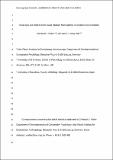Great apes and children infer causal relations from patterns of variation and covariation
Abstract
We investigated whether nonhuman great apes (N=23), 2.5-year-old (N=20), and 3-year-old children (N=40) infer causal relations from patterns of variation and covariation by adapting the blicket detector paradigm for apes. We presented chimpanzees (Pan troglodytes), bonobos (Pan paniscus), orangutans (Pongo abelii), gorillas (Gorilla gorilla), and children (Homo sapiens) with a novel reward dispenser, the blicket detector. The detector was activated by inserting specific (yet randomly determined) objects, the so-called blickets. Once activated a reward was released, accompanied by lights and a short tone. Participants were shown different patterns of variation and covariation between two different objects and the activation of the detector. When subsequently choosing between one of the two objects to activate the detector on their own all species, except gorillas (who failed the training), took these patterns of correlation into account. In particular, apes and 2.5-year-old children ignored objects whose effect on the detector completely depended on the presence of another object. Follow-up experiments explored whether the apes and children were also able to re-evaluate evidence retrospectively. Only children (3-year-olds in particular) were able to make such retrospective inferences about causal structures from observing the effects of the experimenter’s actions. Apes succeeded here only when they observed the effects of their own interventions. Together, this study provides evidence that apes, like young children, accurately infer causal structures from patterns of (co)variation and that they use this information to inform their own interventions.
Citation
Voelter , C J , Sentís , I & Call , J 2016 , ' Great apes and children infer causal relations from patterns of variation and covariation ' , Cognition , vol. 155 , pp. 30-43 . https://doi.org/10.1016/j.cognition.2016.06.009
Publication
Cognition
Status
Peer reviewed
ISSN
0010-0277Type
Journal article
Description
C.J.V. was supported by a scholarship of the German National Academic Foundation.Collections
Items in the St Andrews Research Repository are protected by copyright, with all rights reserved, unless otherwise indicated.

